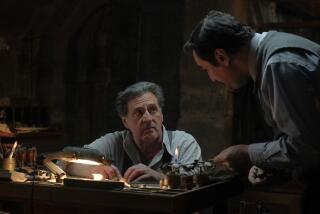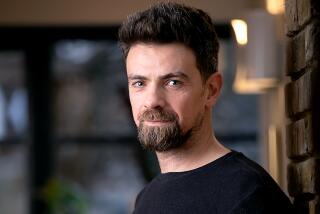Scott Phillips talks about his novel ‘Rake’
Scott Phillips’s latest novel, “Rake” (Counterpoint: 192 pp., $25), is narrated by an actor whose name we never learn. That, of course, is only as it should be, for what’s important is not who he is but who he plays: Dr. Crandall Taylor, a central character in an American soap opera that has become a prime-time hit in France.
The point is that image matters, that we are, in the most fundamental sense, who we say we are. This becomes increasingly apparent as Phillips’ charmingly sociopathic protagonist bluffs his way in and out of danger, hopping from bed to bed and engaging with an international arms dealer, all in the hopes of trying to get a movie made.
It’s new territory for Phillips, who in previous novels such as “The Ice Harvest” and “The Adjustment” has staked out a bluntly brutal landscape: the essence of noir. “Rake,” on the other hand, is sharply funny, a parody (in some sense) of celebrity and the star-making machinery, albeit not without brutality of its own.
Recently, we corresponded, via email, about the book.
“Rake” is a departure, because of both its Parisian setting and its satirical tone. How did it come about?
My French editor, Patrick Raynal, asked me to contribute a novel to a collection he was putting together called ”Vendredi treize.” There were going to be 13 novels by 13 writers, all thrillers, all having some plot element involving Friday the 13th, and they were all going to be filmed for French TV. (This ended up not happening.) So I started writing a book called “Nocturne le vendredi” (the title loosely means “Open Late Friday Nights”), about a character who works in a bookstore, not unlike poor Fred. But that book didn’t gel, and after 70 or so pages I called Patrick and said, “This isn’t working, I’m going to start over again.” That’s where “Rake” came from. The title didn’t change, incidentally; it was published in French as “Nocturne le vendredi,” even though that makes no sense for this book.
You’ve lived in Paris, and later wrote in Hollywood. How did those experiences influence the book?
Some years ago, a good friend of mine, Lane Davies, was starring in a soap called “Santa Barbara” on NBC. It was a huge prime-time hit in France, and he came over with the idea that we’d make a movie. We wrote one, and it was pretty atrocious, and we were probably lucky it never got made, but we met a lot of strange and funny and occasionally unsavory characters in the search for funding. So I came up with the idea of telling an exaggerated version of that story, and I called Lane and asked if he’d mind if I turned him into a violent psychopath for a novel. Fortunately he found the idea funny rather than offensive.
You’re known for hard-boiled novels such as “The Ice Harvest” and “The Adjustment.” What was the impetus for those books?
When I wrote “The Ice Harvest,” I was very much influenced by Charles Willeford, whose way of seeing the world was very comic and very dark. Patricia Highsmith also loved to write about warped, amoral characters but also managed to get the reader to go along with them, which I always found fascinating.
It’s a lot of fun to write a charming, villainous character. You get to experience vicariously things you would never do in reality. Actors have told me the same thing about playing those sorts of roles. The key thing for me is that these characters are masters of self-justification; no one ever thinks of himself as the villain in a story. At one point in “The Adjustment,” the protagonist, Wayne Ogden, having done something awful, gets his feelings hurt when others react angrily, and he declares, “No more Good Samaritan for me!”
In “Rake,” your narrator says, “An art therapist once told me that all art is art therapy.” Is that how you feel?
My cousin Janet Lewis is an art therapist, and her dad, my Uncle Phil, was a painter, and that was his line. It’s probably true, but for most of us it’s an unconscious process. It took me years to realize that “The Ice Harvest” was an autobiographical novel of a life I’d narrowly avoided living.
As a writer you don’t seem to want to be pigeonholed. I think of novels such as “Rut” or “Cottonwood,” as well as “Rake.”
I wrote my second book with the conscious notion that I didn’t want to be rehashing new versions of “The Ice Harvest” over and over again for the rest of my life. But mostly it just comes from the fact that an idea for a book will come to me, and it usually doesn’t exactly fit into one genre or another. I’m a huge fan of Dennis Lehane, who’s done a great job of going back and forth between traditional genre books and his more ambitious novels, and it seems to me that in his case the writing of the former feeds that of the latter and vice versa.
Your books balance the offhand and the deeply plotted; it’s hard to predict what’s going to happen, but in the end they resolve.
I love that feeling reading a book or watching a movie when you don’t know what’s going to happen next or, even better, when you think you know and you’re wrong, and it’s the same for me when I write. I like to have a possible ending just for insurance, and then I’m free to imagine anything I want. My old friend Jim Crumley told me once that several times he’d be 100 or so pages into a novel and then he’d realize he knew how it ended, and he’d lose interest and put it into a drawer. So I improvise and then go back and fix whatever contradicts.
In “Rake,” you write: “Being detail oriented probably helps when plotting out books and movies, but in daily life it seems to add to the stress.”
That goes to my observation that a great many writers are seriously OCD, diagnosed or not. Successful criminals also tend to be detail-obsessed, which dovetails nicely with this type of novel.
ALSO:
Charlie Smith’s ‘Men in Miami Hotels’
More to Read
Sign up for our Book Club newsletter
Get the latest news, events and more from the Los Angeles Times Book Club, and help us get L.A. reading and talking.
You may occasionally receive promotional content from the Los Angeles Times.







